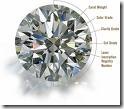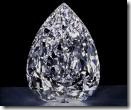When shopping for an engagement ring, it may be helpful to know this terminology.
Diamonds Are Graded By The 4 C's.
(C)olor----(C)larity----(C)arat----(C)ut
THIS PAGE WILL FOCUS ON DIAMOND CLARITY

www.diamondjewelry4u.com Offers 1 Carat Diamond Engagement Rings For $1999 Or Less-Guaranteed!

A Diamonds' Clarity Can Have A Large Impact On Beauty AND Price
Clarity Is Measured On A Scale Of FL to I3.*(FL=Flawless) Flawless Means No Inclusions Or Blemishes Of Any Kind When Examined By A Skilled Grader Under (10X) Magnification
*(IF=Internally Flawless) This Means No Inclusions, and only insignificant surface blemishes are present.
*(VVS1 & VVS2= VERY VERY SLIGHTLY INCLUDED)
*(VVS1) Inclusions in this grade can be EXTREMELY DIFFICULT to see and are only visible from the pavilion, and only with (10X) magnification.
*(VVS2) Inclusions are still difficult to see but easier than (VVS1) You would most likely need (10X) magnification to see them. It is unlikely that the naked eye would be able to see any inclusions in a VVS2 diamond.
* (VS1 & VS2= VERY SLIGHTLY INCLUDED) Minor inclusions are present. These inclusions are SOMEWHAT easy-to-Difficult for a trained grader to see under 10x magnification. It is still unlikely that a naked eye would be able to detect these inclusions.

FL to VS Grades Could Be Considered Unnecessarily Good-Or Luxury Grade. If The 4 C's Are Well Balanced, An (SI) Grade Diamond Can be Very Impressive! The Engagement Ring Above Has An (SI) Grade Center Diamond
* (SI1 & SI2= Slightly Included) Inclusions are seen easy-to-very easy by an experienced grader using (10X) magnification. Possible For the naked eye to see the inclusions without the aid of magnification if looking at the diamond CLOSELY. This would be more true of an (SI2)When shopping for a Diamond Engagement Ring, these two grades are certainly worth Considering. Especially if you are working with a limited budget.
* (I1/I2/I3= IMPERFECT!!!) OBVIOUS INCLUSIONS-These Inclusions Can Usually be seen VERY EASILY without magnification. Inclusions in I3 Diamonds may even THREATEN the durability of the diamond.
Although it is possible for a diamond with a (I1) clarity to look somewhat pleasing to the naked eye, I would suggest purchasing a diamond with a higher clarity if at all possible. Especially when it's for the purchase of an engagement ring.
We have included a Picture Of A "Certified" One carat ROUND BRILLIANT Cut Diamond At The Bottom Of This Page for informational purposes. It's Clarity Grade is (I2) And It's Color Is (F-G) The certificate Was issued By A Company that is Highly Regarded. This diamond was appraised to be worth an Estimated Retail Value of $6,630.00 Dollars. The serial number is laser inscribed on the girdle of the diamond.
Lessons That Can Be Learned Might Be:
#1) This is an example of what you could get if you purchase a diamond with this clarity rating. You Can SEE FOR YOURSELF How Important Diamond CLARITY can be!!
#2) Even A Diamond with GOOD COLOR can LOOK VERY BAD if you do not have the right balance of the 4 C's
#3) Having A Serial Number Laser inscribed on your diamond does not guarantee a High quality or Nice looking Diamond.
#4) "Appraisals" or "Certificates" may not reflect the TRUE VALUE of a diamond. Grading And VALUATION is not considered to be an Exact Science. It Can be very subjective and may even vary by a couple of grades depending upon many factors. Factors such as Lighting/Grading techniques/the ability and-or experience of the appraiser or gemologist/And even the condition or type of equipment being used. This fact is typically covered very extensively in small print, on the back of the certificate with multiple disclaimers. Don't Forget to bring your reading glasses.
#5) Don't possibly overpay for a Diamond Or Diamond Engagement Ring just because A "Professional" or an "Organization" issued a certificate with it. I find that even an amateur can tell if a diamond is good, just by looking at it. If It shines and sparkles like crazy, chances are you have a good one. And You just might be able to save a lot of money by not having that fancy piece of paper!!
If You would like to know more about how you can save a lot of money on your diamond engagement ring, please view our engagement ring selection by clicking one of the links provided or the tab at the top of the page.
"The Sparkle Factor" is what everyone wants in their diamond without spending MORE MONEY THAN THEY CAN AFFORD. It is achieved with a proper balance of (C)olor-(C)larity-And (C)ut.
Of Course the last "C" (Carat Size)does not have any effect on "The Sparkle Factor" However it certainly has an effect on the person showing it off!!!
Although The Diamond Pitured Below Is Certified-It Has A Low Clarity Grade-Diamonds With I1, I2, Or I3 Clarity Grades Are Not Usually Nearly As Beautiful As Higher Grades
A Clarity Enhanced Diamond Engagement Ring Can Offer Remarkable Value-Clarity Enhanced Diamonds Have Been Referred To As "The Diamond Of The Future"
You Can Have The Largest, Most Visually Stunning Diamond You Ever Dreamed Of, For A Price That Has Never Been Possible-Until Now!The Process Works Like This:
The State-Of-The-Art Technology, Optically Eliminates "feathers" which occur in most diamonds. This is Done By Coating The Feather With A Glass-Like Material That Adds Virtually No Weight To The Diamond.
The Transparent "Glass-Like" Material Has Almost The Same Optical And Light Refractive Properties As The Diamond Itself. This Allows Light To Pass Through The Feather (Thereby Masking It)Instead Of Deflecting Off In An Undesirable Direction.
The Result:
A More Visually Stunning Diamond That You Can Purchase For SIGNIFICANTLY LESS Than A Similiar "Non-Enhanced" Diamond.
Best Of All, Clarity Enhanced Diamonds are Totally Natural And Come From The Same Diamond Mines as "Non-Enhanced Diamonds"
The Clarity Enhancement Process Is Totally Invisible To The Naked Eye And Can Even Be Difficult To Detect Under 10x Magnification.
Only A TRAINED Jeweler will Ever Know That You Own A "Clarity-Enhanced Diamond" In Your Ring!!
Fine Diamond Jewelry Deal
![]() For clarity grades F through SI, inclusions (internal flaws) are NOT visible to the naked eye.
For clarity grades F through SI, inclusions (internal flaws) are NOT visible to the naked eye.
When we speak of a diamond's clarity, we are referring to the presence of identifying characteristics on (blemishes) and within (inclusions) the stone.
If you think about the incredible amount of pressure it takes to create a diamond and the fact that natural diamonds are not grown in a sterile laboratory, it's no surprise that most diamonds have flaws.
Basically there are two types of flaws: inclusions and blemishes. Inclusions refer to internal flaws and blemishes refer to surface flaws. However, in the diamond grades listed below, you'll note that none of the grades include the term "blemish" -- for the purposes of grading diamonds, all flaws are called "inclusions."
Inclusions include flaws such as air bubbles, cracks, and non-diamond minerals found in the diamond. Blemishes include scratches, pits, and chips. Some blemishes occur during the cutting processes (most often at the girdle). Diamonds with no or few inclusions and blemishes are more highly valued than those with less clarity because they are rarer.
How are diamonds graded for clarity?
Diamonds are graded for clarity under 10x loupe magnification. Grades range from Flawless (diamonds which are completely free of blemishes and inclusions), to Included 3 (diamonds which possess large, heavy blemishes and inclusions that are visible to the naked eye).
- F
Flawless: No internal or external flaws. Extremely rare. - IF
Internally Flawless: no internal flaws, but some surface flaws. Very rare. - VVS1-VVS2
Very Very Slightly Included (two grades). Minute inclusions very difficult to detect under 10x magnification by a trained gemologist. - VS1-VS2
Very Slightly Included (two grades). Minute inclusions seen only with difficulty under 10x magnification. - SI1-SI2
Slightly Included (two grades). Minute inclusions more easily detected under 10x magnification. REMEMBER: For grades F through SI, a diamond's clarity grade has an impact on the diamond's value, not on the unmagnified diamond's appearance.
REMEMBER: For grades F through SI, a diamond's clarity grade has an impact on the diamond's value, not on the unmagnified diamond's appearance. - I1-I2-I3
Included (three grades). Inclusions visible under 10x magnification AS WELL AS to the human eye. We do not recommend buying diamonds in any of these grades.





F-IF
VVS1-VVS2
VS1-VS2
SI1-SI2
I1-I2-I3
While the presence of these clarity characteristics (inclusions and blemishes) do lower the clarity grade of a diamond, they can also be viewed as proof of a diamond's identity. GIA certificates include what is known as a "plot" of a diamond's inclusions -- think of it as a "diamond fingerprint." Since no two diamonds are exactly the same, comparing the uniqueness of your diamond's clarity characteristics with the plot provided on the diamond certificate offers assurance that the diamond you pay for is the same diamond you receive.


 Although Diamonds That Are graded (D to F) are the most desirable and valuable, Diamonds graded slightly less than colorless ("G" "H" or "I") can be appealing as well, especially if a good balance is maintained with Cut and Clarity as well. They are also a great way to save money. Some sellers will include "J" in this category, however it is my experience that "J" colored diamonds are too yellow to be considered. (Unless You actually desire a yellow diamond-Just make sure you also enjoy the savings that should come with a "J" color diamond!!)
Although Diamonds That Are graded (D to F) are the most desirable and valuable, Diamonds graded slightly less than colorless ("G" "H" or "I") can be appealing as well, especially if a good balance is maintained with Cut and Clarity as well. They are also a great way to save money. Some sellers will include "J" in this category, however it is my experience that "J" colored diamonds are too yellow to be considered. (Unless You actually desire a yellow diamond-Just make sure you also enjoy the savings that should come with a "J" color diamond!!) 








